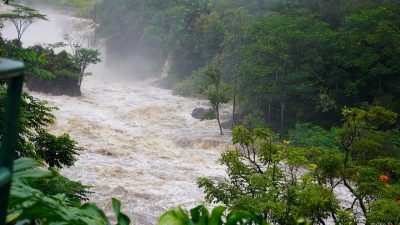Unveiling India’s Deadliest Coastal Disaster And The Cost Of Inadequate Preparedness
The Paradip Cyclone of 1967 is remembered as one of the most tragic natural disasters to strike India. Hitting the coastal region of Odisha with little notice, this storm caused immense destruction, especially in Paradip, a crucial port city. Its sudden ferocity and lack of preparedness led to an overwhelming loss of life and significant damage. The cyclone is a stark reminder of nature’s power and the need for better disaster management systems in the face of such events.
The severity of the cyclone’s impact was compounded by the unanticipated nature of its arrival. Areas that were previously unfamiliar with such powerful storms found themselves completely unprepared, which escalated the devastation. In the years following the disaster, the country was forced to reassess its approach to dealing with extreme weather events, with a particular focus on improving preparedness and response.
The Aftermath of the 1967 Paradip Cyclone: How It Left India Vulnerable
The cyclone’s destructive aftermath left an indelible mark on India, particularly in the affected coastal regions. Paradip, a key port city, faced widespread damage, with its infrastructure—ports, roads, and homes—completely destroyed. The storm’s ferocity also took a toll on local communities, leaving them without homes and basic necessities.
Beyond the physical destruction, the economic fallout was severe. Vital industries were disrupted, and many people lost their jobs. The response from the government was slow, and relief efforts were inadequate. As a result, the affected population faced immense challenges in rebuilding their lives. While steps have been taken to improve disaster response since then, the Paradip Cyclone served as a harsh lesson in the importance of swift and effective action.
The 1967 Paradip Cyclone: A Devastation That Took Lives and Left Communities Broken
- Casualties and Injuries: The death toll from the Paradip Cyclone was horrifying, with estimates of over 10,000 fatalities. Countless others were injured, many severely, and many of them suffered long-term physical impairments. The cyclone’s high winds and the resulting floods were the primary cause of the widespread deaths, while the survivors were left to cope with the emotional and physical toll.
- Widespread Damage: The extent of the damage was truly shocking. Homes, buildings, and critical infrastructure were obliterated, leaving entire communities homeless. Roads and communication networks were destroyed, making it difficult for rescue teams to reach those in need. In addition, agricultural lands were submerged, which had long-term effects on the livelihood of the affected population.
- Community Impact: The cyclone’s effects on local communities were profound. People lost their families, homes, and livelihoods, with the shock and trauma lingering long after the storm passed. The challenge of rebuilding was enormous, and those who survived had to start anew in a world drastically altered by the disaster.
The Unpreparedness of India: What the 1967 Paradip Cyclone Revealed
The Paradip Cyclone of 1967 brought to light India’s glaring shortcomings in disaster preparedness. At the time, India’s meteorological forecasting systems were not advanced enough to predict the cyclone’s sudden intensification. As a result, the affected regions received little to no warning, leaving local authorities unprepared to take action.
This lack of preparedness resulted in a delayed response to the disaster, further compounding the devastation. There were no proper systems in place to warn or evacuate the population, and communities were left vulnerable. This incident highlighted the urgent need for better disaster management infrastructure, including advanced early warning systems and more coordinated disaster response measures.
Could India Have Prevented the 1967 Paradip Cyclone’s Catastrophic Impact?
While no one could have prevented the 1967 Paradip Cyclone itself, the level of devastation was largely due to India’s inadequate disaster management systems at the time. Improved meteorological technology and a better understanding of cyclone behaviour might have helped predict the storm’s intensity, allowing authorities to take preemptive action.
However, beyond the cyclone’s unpredictability, human errors—such as slow evacuations and the mismanagement of resources—contributed to the scale of the disaster. This raised significant concerns about how such natural disasters should be handled and underscored the importance of developing better strategies for response and relief in the future.
Political Consequences of the 1967 Paradip Cyclone: A Closer Look at Accountability
In the wake of the cyclone, there was significant political fallout, as the government’s slow response to the crisis drew heavy criticism. Many believed that authorities failed to act promptly, and the lack of a coordinated rescue operation contributed to the high number of casualties. The absence of clear communication and a delay in relief efforts made it difficult for affected areas to recover in a timely manner.
The disaster raised questions about the efficiency of the government’s disaster management system and its preparedness for such extreme events. In the years following the cyclone, efforts were made to reform disaster response protocols and improve coordination between government agencies and local authorities to avoid repeating the same mistakes.
The 1967 Paradip Cyclone and the Unresolved Theories: What Were the Real Causes?
Like many major natural disasters, the 1967 Paradip Cyclone has been the subject of numerous conspiracy theories. Some argue that the response was hampered by political corruption and inefficiency. Critics claim that resources allocated for disaster relief were not used appropriately, delaying aid to the affected population.
Additionally, some questions have been raised about the cyclone’s sudden arrival and the lack of timely information on its intensity. Was there more that could have been done to predict and mitigate the storm’s impact? The lingering uncertainty around the government’s actions during the crisis fuels ongoing speculation.
Could the 1967 Paradip Cyclone Have Been Mitigated? Uncovering Missed Opportunities
Though a cyclone of this magnitude could not have been stopped, there were opportunities to mitigate its impact. The absence of a reliable early warning system and the lack of preparedness on the ground exacerbated the storm’s effects. Better infrastructure, stronger evacuation plans, and an upgraded disaster management system could have significantly reduced the loss of life and property.
India’s response to the cyclone highlighted the need for proactive disaster risk reduction measures. Had the authorities been more vigilant and prepared, the cyclone might have caused far less damage and fewer fatalities. The lessons learned from this tragic event became the foundation for future improvements in the country’s disaster response frameworks.
Conclusion: A Bitter Reminder of the 1967 Paradip Cyclone’s Devastation
The Paradip Cyclone of 1967 remains a somber reminder of how vulnerable regions can be to natural disasters. The cyclone’s impact highlighted the need for strong early warning systems, more resilient infrastructure, and a rapid response mechanism to ensure that communities are better prepared for such catastrophes in the future. While significant improvements have been made in disaster management since the tragedy, the human and economic toll of the Paradip Cyclone cannot be forgotten.
This devastating event brought attention to the weaknesses in India’s disaster management strategies and paved the way for reforms. However, the grief and loss suffered by those affected by the cyclone remains a painful chapter in India’s history, urging the country to never underestimate the power of nature.
FAQs:
- What caused the 1967 Paradip Cyclone?
The cyclone formed due to a low-pressure system in the Bay of Bengal that rapidly intensified into a violent storm. - How many people were killed in the 1967 Paradip Cyclone?
The cyclone claimed more than 10,000 lives and left thousands more injured or displaced. - What damage did the cyclone cause?
The storm caused widespread destruction, demolishing homes, buildings, and infrastructure, leaving communities in ruins. - Why was the 1967 Paradip Cyclone so unexpected?
At the time, India lacked advanced forecasting systems, and the cyclone struck without significant warning. - What changes were made to disaster management after the cyclone?
The disaster led to significant improvements in early warning systems and disaster preparedness in India.
References:
“98 cyclones hit Odisha from 1891 to ’18”
“A Review of Cyclone and its Impact on the Coastal Belts of Odisha”
“List of natural disasters by death toll”
“A super cyclone hit Orissa coast in the forenoon of”




